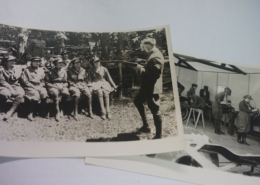Press Contact:
Communications Officer
Mandy Katz, mkatz@tudorplace.org
202.965.0400 ext. 112
Website: www.tudorplace.org
Tudor Place Historic House and Garden
1644 31st Street NW
Washington, DC 2007
Download the PDF
FOR IMMEDIATE RELEASE
January 25, 2012
Washington, D.C. – January 25, 2012 — Tudor Place Historic House & Garden conservators andcurators received a rare glimpse of early American interior design this week with the discovery of a well-preserved sample of block-printed 18th-century wallpaper. The roughly 10-inch piece had been used on a handmade cabinet belonging to George Washington and his wife. Martha Washington’s granddaughter, Martha Custis Peter, and her husband, the founders of Tudor Place, purchased the cabinet in 1802 from Mrs. Washington’s estate.
The wallpaper had covered the top of the Washingtons’ piece, a wax and shellwork tableau
crafted by New York entrepreneur Samuel Fraunces in the 1780s. Its discovery and
conservation portend other valuable insights likely to emerge from study of the Fraunces
piece, which is undergoing a two-year, $37,400 conservation project involving specialists
in wax, textiles, and paper. The Richard C. von Hess Foundation, based in Philadelphia,
Pennsylvania, is funding the project.
“We are thrilled with this significant discovery and look forward to further research
opportunities presented by the samples,” said Tudor Place Executive Director Leslie
Buhler.
Adding further interest to the paper’s discovery are indications that it was manufactured
by a burgeoning domestic industry, rather than in England. A few American wallpaper
manufactories were established by the end of the 1700s, and some produced papers that
surpassed the quality of British or French imports, notes Curator of Collections Erin
Kuykendall. “The simple, repeating floral pattern printed in pink and green is typical for
late eighteenth-century American-made wallpapers,” she said. “Further research may help
identify a specific American manufacturer or retailer.”
Decorating walls with printed papers from England, France, or America was common in elite and middling American households by the late 1700s. Samples rarely survive, however, due to paper’s inherent fragility and householders’ tendency to remove or paint it over time. And samples like this one, over 10 inches in length and bearing multiple design repeats, are particularly rare. Wallpaper samples that do survive are most commonly found sealing the backs of picture frames, covering and lining books, or lining the interior of boxes and trunks, making this an unusual find.
The waxwork paper sample bears a polychromatic floral-and-vine stripe design block printed on laid paper and appears to be torn around the edges. Conservators found it under two additional layers of paper applied over time. The middle piece was a monochromatic blue wallpaper of a lesser quality in extremely poor condition. The outermost layer consisted of a patterned wallpaper dating stylistically to the mid-19th century that had been cut into multiple pieces and attached in a sort of patchwork.
“We were surprised by the excellent condition of the eighteenth-century paper, despite a
significant accumulation of soiling trapped above and below the layer,” noted conservator
Nancy Purinton, of Purinton Preservation, Inc. During the three days removal process,
conservators first humidified the layers to relax the adhesive binding them. Next, using
special spatulas, they gently lifted each layer onto a piece of archival fabric inserted
beneath it. Using the fabric as a support, they then lifted each paper away from the wooden
case.
The wallpaper removal is one of many complicated procedures involved in the overall
conservation of Fraunces’s rare wax and shellwork tableau depicting the Greek warrior,
Hector, bidding farewell to Andromache as he returns to battle. Fraunces, who served as
steward of the Washingtons’ presidential household in Philadelphia, operated Manhattan
enterprises including the Queen Charlotte’s Head Tavern near Wall Street and the former
Vauxhall pleasure gardens on the Upper East Side.
Located in Georgetown’s Historic District, this National Historic Landmark is a house museum distinguished for its neoclassical architecture, decorative arts collection, and five-and-a-half acre garden. Built in 1816, it was home to Thomas Peter and his wife, Martha Custis Peter, granddaughter of Martha Washington. It housed six generations of the Peter family over the course of 180 years. Now, open to the public, the historic home is one of our nation’s hidden gems. For details visit www.tudorplace.org
 https://tudorplace.org/wp-content/uploads/2024/01/Toast-and-Tour-scaled.jpg
2560
1707
Comms2018
https://tudorplace.org/wp-content/uploads/2020/01/2020-01-23-300x155.png
Comms20182024-01-10 16:13:322024-01-22 12:21:46Champagne Toast & Tour
https://tudorplace.org/wp-content/uploads/2024/01/Toast-and-Tour-scaled.jpg
2560
1707
Comms2018
https://tudorplace.org/wp-content/uploads/2020/01/2020-01-23-300x155.png
Comms20182024-01-10 16:13:322024-01-22 12:21:46Champagne Toast & Tour https://tudorplace.org/wp-content/uploads/2023/12/Ancestral-Spacse_web-scaled.jpg
1707
2560
Comms2018
https://tudorplace.org/wp-content/uploads/2020/01/2020-01-23-300x155.png
Comms20182024-03-29 13:55:212024-03-29 13:55:21Ancestral Spaces: People of African Descent at Tudor Place (Tickets for April 30 – May 5)
https://tudorplace.org/wp-content/uploads/2023/12/Ancestral-Spacse_web-scaled.jpg
1707
2560
Comms2018
https://tudorplace.org/wp-content/uploads/2020/01/2020-01-23-300x155.png
Comms20182024-03-29 13:55:212024-03-29 13:55:21Ancestral Spaces: People of African Descent at Tudor Place (Tickets for April 30 – May 5) https://tudorplace.org/wp-content/uploads/2023/12/thumbnail_Website-Image-2.jpg
1280
1920
Comms2018
https://tudorplace.org/wp-content/uploads/2020/01/2020-01-23-300x155.png
Comms20182023-12-08 12:12:582023-12-15 10:49:49Tudor Nights: Up in Arms: A Family’s Service
https://tudorplace.org/wp-content/uploads/2023/12/thumbnail_Website-Image-2.jpg
1280
1920
Comms2018
https://tudorplace.org/wp-content/uploads/2020/01/2020-01-23-300x155.png
Comms20182023-12-08 12:12:582023-12-15 10:49:49Tudor Nights: Up in Arms: A Family’s Service https://tudorplace.org/wp-content/uploads/2024/01/Dirt-Diggers-scaled.jpg
2560
1920
Janet Wall
https://tudorplace.org/wp-content/uploads/2020/01/2020-01-23-300x155.png
Janet Wall2024-01-19 11:52:142024-01-19 16:54:56Dirt Diggers | Garden Volunteering
https://tudorplace.org/wp-content/uploads/2024/01/Dirt-Diggers-scaled.jpg
2560
1920
Janet Wall
https://tudorplace.org/wp-content/uploads/2020/01/2020-01-23-300x155.png
Janet Wall2024-01-19 11:52:142024-01-19 16:54:56Dirt Diggers | Garden Volunteering


